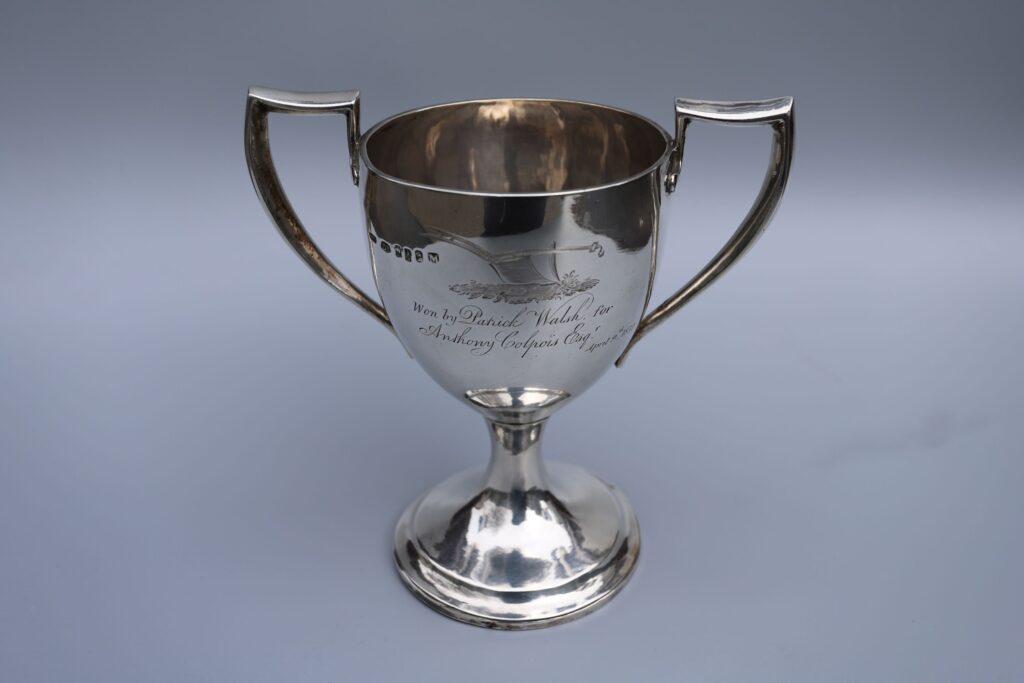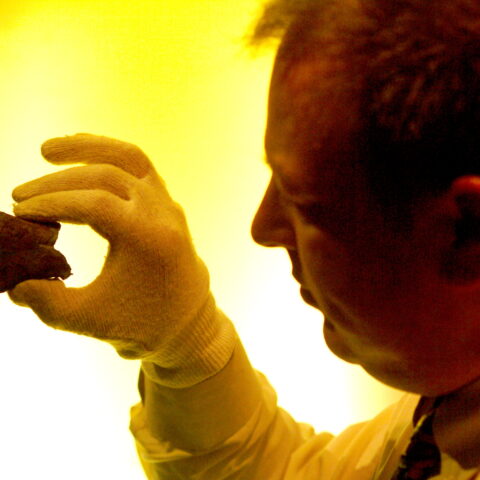The Colpois Cup
This small silver trophy is the Colpois Cup. Won by Patrick Walsh for Anthony Colpois Esq., it was awarded by the Newmarket-on-Fergus Farming Society on April 9th 1832. Patrick Walsh had won the ‘best Gentlemen’s Plough’ competition. Although the word ‘Challengable’ is engraved on one side of the cup, it does not appear that it was awarded again. This is because the only names on the cup were the winners in 1832.
The cup is in the museum collection thanks to the generosity of Grania Weir O’Brien. Grania was born and raised at Dromoland Castle from where she inherited it.
The only other information that we could glean from this trophy until recently was from the hallmark. This is a mark stamped in the silver by the assay office to certify the purity of the silver. The symbols in the hallmark tell us that this cup was made in 1808 and that the silversmith was Daniel Egan. He operated from Bride Street, on the eastern edge of The Liberties, Dublin.
The Ralahine Commune
Recently a search online shed some light on the history of the cup, and the society that awarded it. According to a short paper by the Reverend Ignatius Murphy in the North Munster Antiquarian Journal, the Newmarket Farming Society was set up just after the establishment of the Ralahine Commune in November 1831.
The Ralahine Commune was established by John Vandeleur at Ralahine near Newmarket-on-Fergus. The idea behind the commune was to discourage tenants from becoming involved with secret agrarian societies, such as ‘The Terry Alts’. Agrarian disorder, intimidation and even murder were a feature of daily life in rural Clare in the late 1820s and early 1830s.
The purpose of the commune was:
- To protect members against poverty, sickness and old age through the acquisition of common capital.
- To provide a higher standard of living with a guaranteed income.
- The mental and moral improvement of its adult members
- The education of children
Establishment of the Society
According to Fr. Murphy’s research from the Clare Journal:
‘The inaugural meeting of the Society was held at Mrs Bowen’s Inn, Newmarket-on-Fergus, on 29 December 1831, with William Smith O’Brien in the chair. Sir Edward O’Brien was elected President while John Vandeleur (presumably John Scott Vandeleur of Ralahine) was a member of the committee.’
A number of resolutions were adopted, the second of which read:
‘That the object of the Society be to encourage the improvement of agriculture in the district, by the distribution of Premiums for the best specimens of each class of stock; for the most skilful Ploughing; for the production of the best Green Crops; for Agricultural Implements; and in general to promote the introduction of the most improved methods of farming.’
The Ploughing Competition
The first public activity of the society was a ploughing match at Killula on Monday 19 March 1832. But there was some trouble because one of the landmarks had been removed. This resulted in the abandonment of the ploughing competition.
The Clare Journal reported:
‘We regret to be obliged to mention that in consequence of the misconduct of the peasantry, it was impossible for those holding the ploughs to proceed, of which 26 were entered…’
Could this have been sabotage by resentful tenant farmers? We can speculate. In any case, it was not repeated. The Reverend Murphy tells us:
‘Three weeks later the ploughing match was held again, this time without any trouble, but the number of contestants was considerably reduced.’
This fits with the date on the cup, the 9th April, three weeks after 19th March. According to the Reverend Murphy, the ploughing competition was repeated in March 1833. The winner is unknown, absent from both the Clare Journal and the Colpois Cup.
The Newmarket Farming Society had a similar lifespan to the Ralahine Commune. It began life in late 1831, a few weeks following the start of the Commune. It disappeared from the records before the end of 1833. Late that year, John Vandeleur, committee member of the Farming Society and the man behind the Ralahine commune was at the centre of a great scandal. He disappeared, having lost his fortune gambling at his club in Dublin. He was never heard of again. This resulted in the collapse of the Commune in that same year.
The Reverend Murphy suggests that the emergence of the Newmarket Farming Society is a response to or was inspired by the Ralahine Commune. It is likely also that they me their demise for a similar shared reason and that the Society disappeared either directly or indirectly because of the scandal caused by committee member, John Vandeleur.
References:
Murphy, I (1976) Newmarket Farming Society, 1831-1833, NMAJ No. 30, pp 81-82.


Comments
Deirdre Mulrooney on 30 March 2024:
John Rattigan on 12 April 2024:
Arthur Watson on 9 April 2024:
John Rattigan on 12 April 2024: